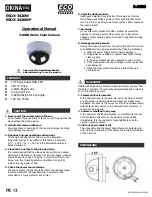
ESP (Electro-Selective Pattern) Metering
Generally, a photograph includes objects with
different levels of brightness. Center-weighted,
averaged light metering is an excellent method for
the majority of ordinary subjects. It averages the
light intensity in a picture frame to determine
exposure. With backlighting and other types of
illumination, however, this metering method may
not provide correct exposure because the light
level often differs between the subjects and back-
grounds. The Olympus OM-4, OM-3 and OM-2S
PROGRAM have
adopted spot metering systems
which allow the photographer to isolate the subject
for specific metering and therefore to obtain more
accurate exposures.
The new ESP metering system has been specifically
developed for the OM-PC to simplify exposure in
these difficult lighting conditions. As soon as you
fire the shutter, the camera will measure the light
intensity in both the center of the frame and outer
area separately. The micro computer then processes
this information, including contrast data, and auto-
matically sets optimum exposure according to the
ESP algorithm*. By simply depressing the shutter
release, you can produce a photograph in which the
subject will appear as you see it with your eyes.
* For further information on ESP algorithm, refer
to page 39.
TTL Direct Off-The-Film "OTF" Light Metering
(Center-Weighted Average Metering)
This is the direct, center-weighted, averaged light
metering system which Olympus pioneered in the
original model OM-2. It measures the brightness of
the subject as the light registers on the film during
the actual exposure. "OTF" metering can respond
to any sudden changes in light during exposure, and
therefore it is very advantageous for taking quick
candid shots and fast moving subjects. In flash
photography with an Olympus T-Series flash, this
"OTF" Light Metering method will also fully
control the flash exposure, thereby eliminating any
need for complicated guide number exposure
calculations. You can work with all available aper-
tures of your lens and use sophisticated techniques
such as bounce flash and multi flash in a fully
automatic mode. It has also solved difficult ex-
posure problems with macrophotography.
34
Summary of Contents for PC I
Page 1: ......
Page 4: ...3...
Page 6: ...Remove the rear lens cap Remove the body cap 1 2 Mounting the Lens 5...
Page 24: ...Manual Exposure 1 Set the mode selector dial to the MANUAL position 2 Set the aperture 23...
Page 29: ...Other Operations 28...
Page 30: ...Using the Self Timer 1 2 Wind the film once Set the self timer lever 29...
Page 56: ...55...
Page 67: ...For Longer Service of Your Camera 66...
Page 68: ...Handling Care Take care in handling the camera Do not apply excessive force 67...
















































